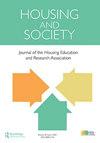Guest editors’ introduction to the special issue on housing and health
Q2 Social Sciences
引用次数: 0
Abstract
Introduction Since the early 19 century, many communities in the United States and Europe have recognized the connection between housing and health. Within urban areas, industrial development grew rapidly, and tenement housing conditions deteriorated due to overcrowding and housing age (Centers for Disease Control and Prevention & U.S. Department of Housing and Urban Development, 2006). Most health professionals were concerned with the spread of contagious diseases, such as cholera, smallpox, and typhus (Jacobs & Hershovitz, 2011). Thus, many municipalities, including New York City, established housing codes and design standards to improve these plighted conditions. One of first prominent American public health officials to advocate for a housing code was Dr. John H. Griscom who was hired by the City of New York in 1845 to investigate mortality and disease among workers and low-income families. Other housing reformers were Edward Potter, Ernest Flagg, Isaac Newton Phelps Stokes, Grosvenor Atterbury, Henry Atterbury Smith, Andrew J. Thomas, Clarence Stein, Henry Wright, Frederick Akcerman, Lawrence Veiller, Edith Elmer Wood, Catherine Bauer Wurster, and Mary Kingsbury Simkovitch (Plunz, 2016). Yet others were Jacobs Riis who reported about the poor living conditions of immigrant workers in his book How the other Half Lives (Riis, 1971). These efforts lead to recommendations to establish New York City’s municipal health department in 1866, the first municipal health department in the U.S., and to pass the New York City Tenement House Act of 1867, the first municipal housing code in the nation (Garb, 2003; Hoffman, 1998; Proscio, 2004). This law required minimum ventilation standards and connections to sewer and fire escapes, among other regulations (Hoffman, 1998). However, the Tenement House Act of 1867 was not enforced and still permitted construction of air shafts that were considered hazardous. Thus, reformers continued to push for passage of updated Tenement House Acts in 1879, 1887, 1895, 1901, and 1919 to address the many weaknesses and weak enforcement (Hoffman, 1998). For example, the Tenement House Act of 1901 (“New Law”) established strict standards to mitigate the problems of overcrowding, apartment fires, poor ventilation, and unsanitary conditions, and became a model code for many other communities (Garb, 2003; Hoffman, 1998). Today, housing is still fundamental to people’s quality of life and has a direct impact on their health and well-being (Basolo, 1999). Poor housing conditions may positively and negatively impact one’s health. In the case of the latter, interventions are needed (Health特邀编辑对住房和健康特刊的介绍
自19世纪初以来,美国和欧洲的许多社区已经认识到住房与健康之间的联系。在城市地区,工业发展迅速,由于过度拥挤和住房老化,廉租房条件恶化(疾病控制和预防中心&美国住房和城市发展部,2006年)。大多数卫生专业人员关注传染病的传播,如霍乱、天花和斑疹伤寒(Jacobs & Hershovitz, 2011年)。因此,包括纽约市在内的许多城市制定了住房法规和设计标准,以改善这些恶劣的条件。约翰·h·格里斯科姆博士(Dr. John H. Griscom)是最早倡导制定住房法规的美国著名公共卫生官员之一,他于1845年受聘于纽约市,调查工人和低收入家庭的死亡率和疾病。其他住房改革家有爱德华·波特、欧内斯特·弗拉格、艾萨克·牛顿·菲尔普斯·斯托克斯、格罗夫纳·阿特伯里、亨利·阿特伯里·史密斯、安德鲁·托马斯、克拉伦斯·斯坦、亨利·赖特、弗雷德里克·阿克曼、劳伦斯·维勒、伊迪丝·埃尔默·伍德、凯瑟琳·鲍尔·伍斯特和玛丽·金斯伯里·西姆科维奇(普伦茨,2016)。还有雅各布斯·里斯(Jacobs Riis),他在《另一半的生活》(How the other Half Lives, Riis, 1971)一书中报道了移民工人恶劣的生活条件。这些努力导致建议在1866年建立纽约市市政卫生部门,这是美国第一个市政卫生部门,并通过了1867年《纽约市廉租房法》,这是美国第一个市政住房法典(Garb, 2003年;霍夫曼,1998;Proscio, 2004)。这项法律要求最低的通风标准和连接到下水道和消防通道,以及其他规定(Hoffman, 1998)。然而,1867年的《房屋租赁法》并没有强制执行,仍然允许建造被认为是危险的通风井。因此,改革者在1879年、1887年、1895年、1901年和1919年继续推动通过更新的《租住房屋法》,以解决许多弱点和执行不力的问题(Hoffman, 1998)。例如,1901年的《租住房屋法》(“新法”)制定了严格的标准,以减轻过度拥挤、公寓火灾、通风不良和不卫生条件等问题,并成为许多其他社区的示范规范(Garb, 2003;霍夫曼,1998)。今天,住房仍然是人们生活质量的基础,对他们的健康和福祉有直接影响(Basolo, 1999)。恶劣的住房条件可能对人的健康产生积极和消极的影响。在后一种情况下,需要采取干预措施(卫生
本文章由计算机程序翻译,如有差异,请以英文原文为准。
求助全文
约1分钟内获得全文
求助全文
来源期刊

Housing and Society
Social Sciences-Urban Studies
CiteScore
2.30
自引率
0.00%
发文量
10
期刊介绍:
Housing and Society is the journal of the Housing Education and Research Association (HERA). The journal supports the mission of HERA by providing for the dissemination of research and other scholarly work. Submissions from a broad range of perspectives are encouraged. Topics in housing include: policy, design, social aspects, gerontology, behavioral aspects, energy/environment, equipment, interiors, economics, theory/model development, education, and program development or evaluation. The journal welcomes the submission of original research articles, notes and commentaries. Notes are shorter manuscripts presenting succinct information on housing related to one of the following categories: - Research: exploratory or not heavily theory-based or statistically analyzed - Academic: innovative teaching ideas - Program: development, implementation, and/or evaluation of Cooperative Extension or other housing programming efforts - Policy: examination of policy impact, comparative analysis, and/or need to achieve housing goals - Reviews: books, documentaries, etc.
 求助内容:
求助内容: 应助结果提醒方式:
应助结果提醒方式:


